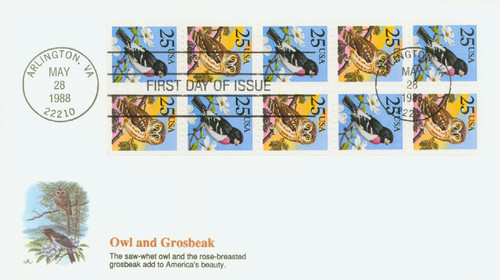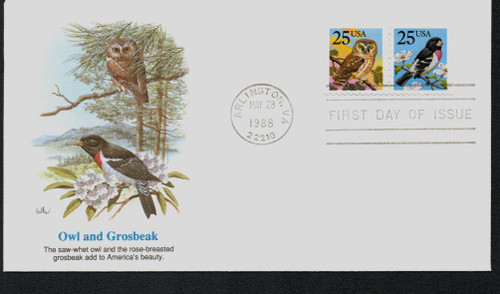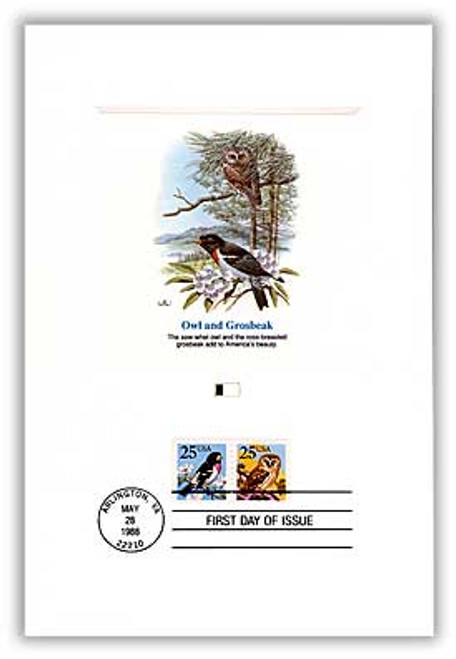
1988 25c Owl/Grosbeak Full Pane Cover
# 2285B FDC - 1988 25c Owl/Grosbeak Full Pane Cover
$3.50 - $8.00
U.S. #2285b
1987 25¢ Owl and Grosbeak
1987 25¢ Owl and Grosbeak
Booklet Pane of 10
Issue Date: May 28, 1988
City: Arlington, VA
Printed By: Bureau of Engraving and Printing
Printing Method: Photogravure
Perforations: 10
Color: Multicolored
City: Arlington, VA
Printed By: Bureau of Engraving and Printing
Printing Method: Photogravure
Perforations: 10
Color: Multicolored
The Grosbeak and Owl booklet pane of 10 was originally going to feature one bird. However, when the USPS saw artist Chuck Ripper’s designs, they were so pleased they decided to use both of them. The booklet is arranged in a unique checkerboard pattern to accommodate both subjects.
A member of the finch family, the rose-breasted grosbeak is found mainly in the Northeast. Like many of our other fine-feathered friends, the bright colors are restricted to the males.
Nearly the same size as the grosbeak, the saw-whet owl is one of the smallest birds of prey. His fine-tuned senses, such as binocular-like eyesight and keen hearing, plus the fluffy plumage allows him to swoop down silently on his prey.
U.S. #2285b
1987 25¢ Owl and Grosbeak
1987 25¢ Owl and Grosbeak
Booklet Pane of 10
Issue Date: May 28, 1988
City: Arlington, VA
Printed By: Bureau of Engraving and Printing
Printing Method: Photogravure
Perforations: 10
Color: Multicolored
City: Arlington, VA
Printed By: Bureau of Engraving and Printing
Printing Method: Photogravure
Perforations: 10
Color: Multicolored
The Grosbeak and Owl booklet pane of 10 was originally going to feature one bird. However, when the USPS saw artist Chuck Ripper’s designs, they were so pleased they decided to use both of them. The booklet is arranged in a unique checkerboard pattern to accommodate both subjects.
A member of the finch family, the rose-breasted grosbeak is found mainly in the Northeast. Like many of our other fine-feathered friends, the bright colors are restricted to the males.
Nearly the same size as the grosbeak, the saw-whet owl is one of the smallest birds of prey. His fine-tuned senses, such as binocular-like eyesight and keen hearing, plus the fluffy plumage allows him to swoop down silently on his prey.








